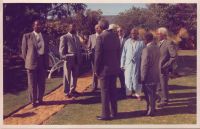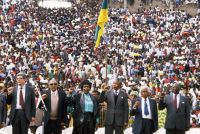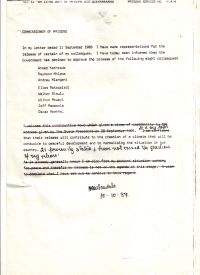Almost 28 years after freedom fighter Nelson Mandela left Soweto for a life underground and then imprisonment, a helicopter delivered him back.
It dropped him at Soccer City, a football stadium whose capacity crowd included some of his comrades who had been sentenced with him to life imprisonment.
“It’s unforgettable,” said Ahmed Kathrada, of the Welcome Home Rally on 13 February 1990 where he and other comrades were reunited with Mandela. “It was very exciting. There were thousands and tens of thousands of people celebrating with us.”

Remaining Rivonia trialists, as well as Wilton Mkwayi and Oscar Mpetha, visiting Nelson Mandela at Victor Verster Prison. Image courtesy of the National Archives of South Africa
In stark contrast to the few steps to freedom he had taken from Victor Verster Prison two days before, this time he and his comrades, his wife Winnie, and their daughter Zindzi, carrying his youngest grandchild, strode around the edge of the soccer pitch between a mass of photographers on their left and a sea of supporters on their right.
Before taking to a makeshift podium to speak he embraced George Bizos and Arthur Chaskalson, two of the lawyers who had defended the Rivonia Trialists. South Africa was inching out of the system of apartheid, but overturning the legacy of racial prejudice remained an enormous challenge.
“Today, my return to Soweto fills my heart with joy,” Mandela said. “At the same time, I also return with a deep sense of sadness. Sadness to learn that you are still suffering under an inhuman system.”
Mandela was only able to return to his house at 8115 Vilakazi Street after the rally. He had spent his first night of freedom in Cape Town at the official residence of Anglican Archbishop Desmond Tutu. After giving his first press conference there on 12 February, he was flown to Johannesburg where he stayed at the home of a supporter, Sally Cohen, and the next day flew by helicopter to Soweto.

Arthur Chaskalson, Ahmed Kathrada, Winnie Mandela, Nelson Mandela, Walter Sisulu and Andrew Mlangeni at the Welcome Home Rally in Soweto, taken on 13 Feb 1990. Image courtesy of Louise Gubb
Before he was freed, he had ensured that the remaining Rivonia Trialists were released. Denis Goldberg had been released in February 1985 and Govan Mbeki in November 1987.
The last time ‘prisoner Kathrada’ saw ‘prisoner Mandela’ was at Victor Verster Prison on 10 October 1989, when he and other comrades had visited him in the house where he was held for the last 14 months of his imprisonment.
Kathrada recalls the moment they parted as if it were yesterday: “He said, ‘Chaps, this is goodbye’. So we said we’ll believe it when it happens’.” Mandela told them he had just taken leave of two cabinet ministers who assured him that his comrades would be freed.
Instead of returning to Pollsmoor Prison, they were given supper in the Victor Verster Prison dining hall. And then, just in time for the evening news, a television was brought in. An announcement was made that President FW de Klerk had decided to release “the following eight prisoners”.

Letter to the Commissioner of Prisons regarding the release of eight colleagues. Image: Nelson Mandela Foundation
“Naturally I looked for my own name and it was number eight,” Kathrada chuckled.
The prisoners to be released were the remaining Rivonia Trialists: Kathrada, Walter Sisulu, Raymond Mhlaba, Andrew Mlangeni and Elias Motsoaledi, Kathrada. The other three were Wilton Mkwayi, Oscar Mpetha and Jeff Masemola.
The group was returned to Pollsmoor Prison and three days later they were transferred. Kathrada, Sisulu, Mlangeni, Motsoaledi, Mkwayi and Masemola were flown to Johannesburg where they were held at Johannesburg Prison. Mhlaba went to his hometown of Port Elizabeth and Mpetha, who was from Cape Town, remained for until his release at Groote Schuur Hospital where he was being treated.
On the night of Saturday 14 October, the Commanding Officer of Johannesburg Prison approached the prisoners and said, ”We’ve just received a fax from prison headquarters that you are going to be released tomorrow.” The response from Kathrada, who had then been in prison for over 26 years: “What’s a fax?”
Very early the next morning after their obligatory medical check-ups and the return of their possessions, they were driven home. Within four months they were standing with their Commander-in-Chief on the stage in Soweto. The returning hero had outlined the challenges ahead but highlighted the role of ordinary people who had helped make the changes.
“It is not the kings and generals that make history, but the masses of the people,” said Mandela towards the end of his Soweto speech. “I have always believed in this, but not to the extent to which I now believe that basic principle, because I have seen with my own eyes, the masses of our people, the workers, the peasants, the doctors, the lawyers, the clergy, all our people. I have seen them making history, and that is why all of us are here today.”
The next week he received his first South African passport and soon embarked on a journey of gratitude around the world. His comrades accompanied him on the first stop – the headquarters of the ANC in exile. From then on it was a whirlwind of travel and talks until multi-party negotiations resulted in the setting of a date for South Africa’s first democratic elections for 27 April 1994.
Madiba and Kathrada. Image courtesy of NMF/ Debbie Yazbek
Four years and three months after his release from prison, Nelson Rolihlahla became South Africa’s first democratically elected President. In creating his cabinet he had included Kathrada as Minister of Correctional Services but his long-time comrade did not agree. He settled on becoming his Parliamentary Counsellor.
Now 85-years-old and just an ordinary member of the ANC Kathrada, who knew Mandela for more than 60 years has hopes for the youth.
“Just to remind them, which we often do, that with freedom comes responsibility,” he said “All the avenues are open to them now which were closed before. So they should realise their responsibilities and take on those responsibilities as the situation demands. That’s what we need.”
Ends
Bottom row: Billy Nair and Nelson Mandela. Top row from left to right: Laloo “Isu” Chiba, Michael Dingake, Kwedi Mkalipi, Eddie Daniels, Ahmed Kathrada. Image courtesy of the NMF/Benny Gool